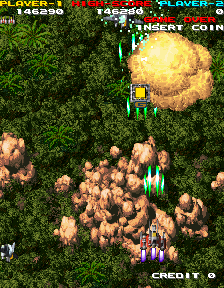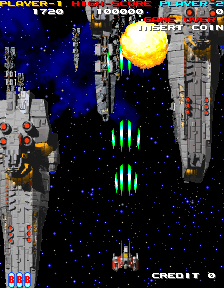






| Arcade Game Review |
| NebulasRay |
| Developed by Namco (March 1994) |
| NKD (5 Oct. 2019) The 1990's can be considered Namco's second "golden age", seeing as how it was the generation we've been blessed with classics such as Ridge Racer, Soulcalibur, Tekken and Time Crisis. A game that simply failed to meet the mark, however, is the little-known NebulasRay, released at a time where shoot'em ups were often seen as an outdated genre compared to the "new" and "exciting" wave of fighting games that were slowly making their way forth. While some games, such as RayForce and DonPachi were massively successful, others simply failed to make a splash. NebulasRay is without a doubt part of the latter. Given a very limited release in 1994, NebulasRay has the distinction of being the very last original shmup from the company, as all other games in the genre they produced in the years following were updates or sequels to Galaxian and Xevious. Despite Namco trying their best to hype up the game (even by giving it a television commercial, one of the company's only arcade games to have such a thing), it proved to be an underwhelming failure. The game has also never seen any sort of home release either, not even being given a slot in the endless stream of Namco Museum collections produced for every platform under the sun. And really, for being Namco's last original shmup and being one of their most obscure titles in the arcades, NebulasRay is actually a pretty good title in its own right, albeit with some rather dated and annoying mechanics.  The game's attract mode sequence starts off with a series of cutscenes explaining the game's storyline. The plot isn't much to write home about, but for a game like this I don't expect a whole lot. The story basically involves the human race dividing up into two groups - the Rebels and the Master Force - and needless to say they don't like each other. The Master Force basically blows up the Rebel forces' base of operations on the planet Marinaric, in which the game dubs the "Lost Marinarc Incident". With the Rebels in trouble, you're tasked with controlling a powerful starfighter named the Fighting Ray to fight off the Master Force and restore peace in the galaxy. It's not much, but at least they tried something different instead of the "alien race coming down to wipe out the humans" trope that many of these games use. The game's attract mode sequence starts off with a series of cutscenes explaining the game's storyline. The plot isn't much to write home about, but for a game like this I don't expect a whole lot. The story basically involves the human race dividing up into two groups - the Rebels and the Master Force - and needless to say they don't like each other. The Master Force basically blows up the Rebel forces' base of operations on the planet Marinaric, in which the game dubs the "Lost Marinarc Incident". With the Rebels in trouble, you're tasked with controlling a powerful starfighter named the Fighting Ray to fight off the Master Force and restore peace in the galaxy. It's not much, but at least they tried something different instead of the "alien race coming down to wipe out the humans" trope that many of these games use. The thing that makes NebulasRay stick out among the crowd of generic space-shooting games is actually its graphics. Very similar to Nintendo's Donkey Kong Country or Seta's Twin Eagle II, NebulasRay uses pre-rendered models for its graphics and backgrounds, which were apparently designed on a Macintosh computer. They're pretty dated in today's standards, and is pretty choppy with its animations, but for a game released in 1994 (early '94, mind you), this is pretty damn impressive. The environments you traverse through are also colorful, vibrant and detailed, bursting full with eye-candy. The graphical effects are also well-done, such as the warp effects and that waving starfield in the first stage. The sprites also don't blend in with the background either, so you can easily see where projectiles and enemies are without risking the loss of a life. There are a few oddities, however, such as the rather sharp edges alongside the background graphics. The soundtrack is absolutely fantastic, and it's definitely one of the highlights of the game. Composed jointly by Masahiro Fukuzawa and Takayuki Ishikawa, I dare to say it's one of Namco's best soundtracks for any of their arcade games. The first stage opens up with the blood-pumping track "Exeo", a wonderfully-composed song that really sets the mood for the game - an entergetic, thrilling voyage through the skies. Much of the music is also very catchy and will get stuck in your head even long after playing. One of my favorite tracks is actually the continue theme, "Failure", and despite its negatively-named title is a great bit of music, and probably the best continue theme I've heard for a game aside from Gokujou Parodius (which, funnily enough, came out the same year). Thankfully this soundtrack got a physical release from the folks at Victor Entertainment later on in 1994 as the thirteenth album in their Namco Game Sound Express series, although sadly goes for a pretty penny online.  The thing that Namco slacked on with this game, however, is the gameplay. It's not horrible by any means, but it's pretty dull andaverage compared to the likes of RayForce. It's still the same old shoot enemies and avoid projectiles thing like many others have done.There's nothing about it that really makes it standout among others.......well, aside from the difficulty. Saying this game is hard is an understatement, as after the second stage it basically rains down HELL on you with an onslaught of quick-moving enemies and projectiles, instantly turning the game from a fairly easy shmup to a bullet-hell game that's on Cave-levels of hard. Later bosses also require a ridiculous number of hits to defeat, which when piled on by the excessive amount of projectiles and other junk they launch towards you can make for a pretty frustrating experience. And if that wasn't enough, after beating all six stages you're "treated" (and I use that term loosely) to an extra challenge stage, which basically tosses you back into the first level with lightning-quick enemies and even faster projectiles - if you manage to make it here, good luck. The thing that Namco slacked on with this game, however, is the gameplay. It's not horrible by any means, but it's pretty dull andaverage compared to the likes of RayForce. It's still the same old shoot enemies and avoid projectiles thing like many others have done.There's nothing about it that really makes it standout among others.......well, aside from the difficulty. Saying this game is hard is an understatement, as after the second stage it basically rains down HELL on you with an onslaught of quick-moving enemies and projectiles, instantly turning the game from a fairly easy shmup to a bullet-hell game that's on Cave-levels of hard. Later bosses also require a ridiculous number of hits to defeat, which when piled on by the excessive amount of projectiles and other junk they launch towards you can make for a pretty frustrating experience. And if that wasn't enough, after beating all six stages you're "treated" (and I use that term loosely) to an extra challenge stage, which basically tosses you back into the first level with lightning-quick enemies and even faster projectiles - if you manage to make it here, good luck. Of course, every shmup has gotta have power-up items, and in NebulasRay they're actually quite useful and interesting in their own right. Power-ups are dropped by cylindrical-shaped "Capsules" (which are also enemies), and will provide the player with new weapons or other items. The most common is the Glow/Grow Shot that increases the width of your standard projectiles, and collecting more of them will increase the width even further, and the pulsating effect it has is pretty nifty. You also have the traditional spread shot that really makes the later stages easier to progress through. Some items however, are only limited and last for a set time limit as indicated at the top of the screen - these include a protective shield, powerful bombs that make it easier to destroy ground targets, a four-way shot, and an oddly-satisfying red twin-shot that locks onto enemies. If things are getting hairy, you can also launch a powerful (and pretty mucky-looking) smart bomb that wipes out everything on the screen. Something that readers might have noticed is the simularities between NebulasRay and the aforementioned RayForce, and it's easy to see why - the stage layouts are similar, the background designs are pretty similar, and even the name sounds like they took a bit of.....inspiration from Taito's game. Supposedly NebulasRay was actually in development first (in fact, Namco beat Taito to the punch with the use of pre-rendered graphics, which infuriated RayForce designer XXX), but the amount of similarities between the two makes it somewhat difficult to simply pass it off as a coincidence. Then again, both of these titles are only a month or so apart (RayForce was released in February of that year, a month before), so it's really up to you to decide. |
| The Verdict |
| The main issue with NebulasRay is that it doesn't do a whole lot to stick out from other cookie-cutter shooters, and sadly makes it sorta lost in a sea of "me too" games. Despite this, it manages to be a fun and interesting shmup, with some colorful graphics, an excellent soundtrack and good co-op gameplay. The difficulty, while being unforgiving as hell at times, strangely adds to the entertainment value, giving you an adrenaline rush and fueling you to keep playing. There's no home port of this game (not even for mobile phones, a platform Namco dumped everything from Blast Off to Cutie Q onto), so your only option here is to play it through MAME - but even then it's not the greatest, since there's a lot of slowdown issues that make the game unbearable at times. Aside from brief cameos in the Ridge Racer and Famista franchises, NebulasRay has been pretty much forgotten by Namco. Which is really a shame, as even with its issues it's a pretty damn good shoot'em up - and, dare I say, a hidden gem. |
| 7/10 |
2019 Namcokid47. Content here is by myself unless noted. Do not use original material without permission.